The older we get, the more comfortable we seem to get with talking about our cycles. I think it’s because it’s something that we’re getting more and more used to as we grow over. We begin to realize what’s normal for us and what isn’t normal. And with period tracking apps, these days it’s even easier to know what’s normal month to month.
I had a friend tell me once that she used to always get a very sharp pain in her abdominal area when she was ovulating. At first, she wasn’t sure what this pain was, but as she started tracking her period, she began to realize that it was relatively normal for her. Recently, I’ve been noticing that I too experience more of my abdominal pain symptoms (usually caused by ETAP) while running during my ovulation time table. I can’t say for sure if those two things are related, but it did get me thinking about how many women probably actually experience this kind of pain. When is experiencing ovulation pain normal and when is it something you should be talking to you OBGYN about?
What is pain during ovulation?
 The technical pain for abdominal pain during ovulation is mittelschmerz, which is medically defined as lower abdominal pain on one side of the abdomen. This pain usually occurs about 14 days before your next menstrual period, right about the time when you are ovulating.
The technical pain for abdominal pain during ovulation is mittelschmerz, which is medically defined as lower abdominal pain on one side of the abdomen. This pain usually occurs about 14 days before your next menstrual period, right about the time when you are ovulating.
The pain is usually described as either a dull, cramp-like pain or a sudden, sharp pain at one side of the lower abdomen. This pain is usually, but not always accompanied by blood or discharge. The pain occurs on one side of the abdomen, as that is the side that is releasing the egg (Mayo Clinic, 2019).
What causes Mittelschmerz?
As we have established, Mittelschmerz occurs during ovulation, the phase in which the egg-containing follicle ruptures to release the egg. It’s thought that this pain may occur because as the follicle grows before rupturing, it may stretch the surface of the ovary causing pain. Similarly, blood or fluid that comes from the ruptured follicle can irritate the lining of the abdomen and cause pain. Although it is not 100% known what the for sure cause for this pain is, these theories are the most practical estimate that researchers currently have discovered (Mayo Clinic, 2019).

During the Follicular phase of the cycle, the follicle ruptures and releases the egg. This is when Mittelschmerz is said to occur. (Photo is retrieved from the period tracking app: Clue)
What can be done for Mittelschmerz Pain?
Usually, medical attention isn’t needed for this type of pain, similar to how medical attention isn’t usually needed for cramps. This is especially true if you have noticed that this is normal for your cycle. For the most part, an over the counter pain medication, such as ibuprofen, will help to relieve symptoms (Mayo Clinic, 2019).
What if it becomes too bad?
If the pain is too intense, an oral contraceptive can be prescribed to better control the menstrual cycle. However, before you jump into this sort of situation, I think it’s something you should highly talk about with your doctor to make sure you go on the right type of contraceptive with the right dosing for you. (In the future I want to make a post about some real-life stories of how people have reacted to contraceptives, but we’ll see if that ever happens).
When should you see your doctor?
A trip to your OBGYN might be needed when the pain is so intense that it is interfering with your normal, day to day activities, if pain is occurring outside your ovulation window, if your mid-cycle bleeding becomes heavy and mimics that of your period, or if you develop a fever or other symptoms along with pain (Nwadike, 2018).
All in all, pain around different parts of your cycle is all totally normal. Being a woman can be so much fun sometimes, especially if you are in pain twice a month all because of your cycle. However, as long as the pain is normal and manageable, it’s nothing you should be concerned about. Just keep tracking your period and recognizing what is normal for you so in case something out of the normal does happen, you’ll be right on top of it!
What other cycle topics do you want me to talk about coming up? Let me know in the comments below.
Until next time,
Kat
Sources and further reading:
Mayo Clinic (2019). Mittelschmerz. Retrieved from: https://www.mayoclinic.org/diseases-conditions/mittelschmerz/symptoms-causes/syc-20375122
Nwadike, V.R. (2018). What does ovulation pain mean? Medical News Today. Retrieved from: https://www.medicalnewstoday.com/articles/323572.php
 Spotting is considered to be any bleeding outside the normal cycle. And although it isn’t uncommon for women, it is considered irregular. Sometimes bleeding between periods can be a sign of something serious going on inside your body, especially if the “spotting” is more like a light flow than a couple of drops. But other times, period spotting can be caused by something not very serious and is just a part of life.
Spotting is considered to be any bleeding outside the normal cycle. And although it isn’t uncommon for women, it is considered irregular. Sometimes bleeding between periods can be a sign of something serious going on inside your body, especially if the “spotting” is more like a light flow than a couple of drops. But other times, period spotting can be caused by something not very serious and is just a part of life.